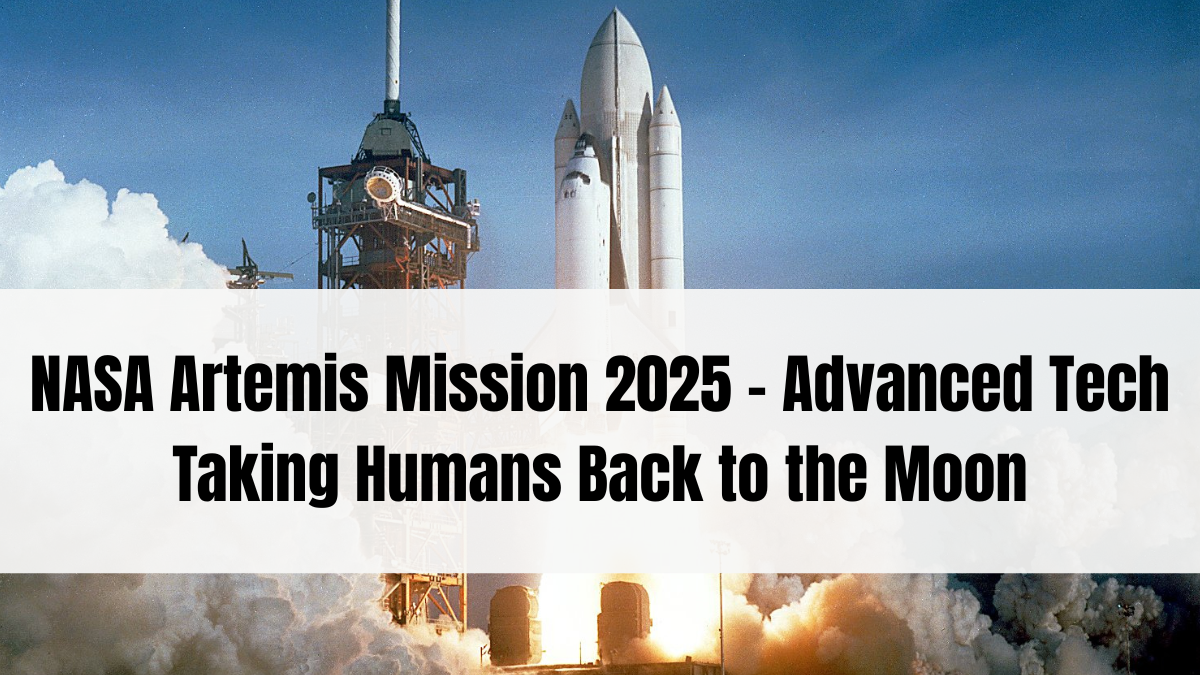The NASA Artemis Mission 2025 marks a groundbreaking return to lunar exploration, aiming not just to land astronauts on the Moon but also to establish long-term human presence and test advanced technologies for future Mars missions. Unlike the Apollo missions of the past, Artemis uses modern innovation, public-private partnerships, and sustainable practices to redefine humanity’s journey into space.

Table of Contents
What Makes the Artemis Mission Different from Apollo?

The Artemis program is built on decades of research, with the goal of being more inclusive, technologically advanced, and globally collaborative than Apollo. Key differences include:
-
Inclusion of the first woman and first person of color to land on the Moon.
-
Use of the Space Launch System (SLS) – the most powerful rocket ever built.
-
Development of the Gateway lunar space station.
-
Reusable landers and long-term lunar habitat plans.
Key Technologies Powering the NASA Artemis Mission 2025
NASA’s Artemis Mission uses a suite of modern technologies to achieve success:
-
Space Launch System (SLS): Heavy-lift rocket that powers missions beyond low Earth orbit.
-
Orion Spacecraft: Designed for deep-space travel with life-support and navigation systems.
-
Gateway Station: A lunar orbiting outpost to serve as a staging point for surface missions.
-
HLS (Human Landing System): Lander built by SpaceX’s Starship and other partners.
Here’s a look at the major tech involved:
| Technology | Description |
|---|---|
| SLS | Launches crew and cargo beyond Earth’s orbit |
| Orion Capsule | Carries astronauts safely to the Moon and back |
| Gateway | Orbital station for lunar transfer and research |
| Lunar Landers | Designed to ferry astronauts from Gateway to Moon |
Timeline and Mission Objectives for 2025
The 2025 Artemis mission follows several successful unmanned tests. In Artemis III, astronauts are scheduled to land near the Moon’s south pole — a region rich in water ice, vital for future survival and fuel production.
Mission Goals Include:
-
Conduct scientific experiments on lunar soil.
-
Test life-support systems in extreme environments.
-
Establish protocols for future Mars missions.
-
Return lunar rock and regolith samples.
International and Private Collaboration
The NASA Artemis Mission 2025 is not just a US effort — it is backed by global support through the Artemis Accords, with participation from the European Space Agency (ESA), JAXA (Japan), and CSA (Canada). Moreover, private companies like SpaceX and Blue Origin are contributing hardware, crew modules, and cargo services.
Key Artemis Partners:
-
NASA (USA)
-
ESA (Europe)
-
JAXA (Japan)
-
CSA (Canada)
-
SpaceX, Boeing, Lockheed Martin
Future Impact of Artemis on Space Travel
The mission is a stepping stone to Mars, enabling deeper space operations, in-space manufacturing, and interplanetary navigation. Technologies tested during Artemis will pave the way for building lunar bases, using 3D-printed habitats, and refining propulsion systems for long-duration travel.
The NASA Artemis Mission 2025 is not just about visiting the Moon—it’s about changing the future of space travel forever.
FAQs
What is the NASA Artemis Mission 2025 about?
It aims to land astronauts on the Moon again, with advanced technologies and a focus on sustainability and Mars preparation.
How is Artemis different from Apollo?
It includes more diversity, international collaboration, reusable systems, and long-term lunar goals.
Will Artemis 2025 really send humans to the Moon?
Yes, Artemis III plans to send astronauts to the Moon’s south pole region using the SLS and Orion systems.
Who is building the lunar lander for Artemis?
SpaceX’s Starship has been selected as one of the Human Landing Systems (HLS) for Artemis III.
What comes after Artemis 2025?
Future Artemis missions aim to build lunar bases and conduct deeper space exploration, including human missions to Mars.
Click here to know more.






